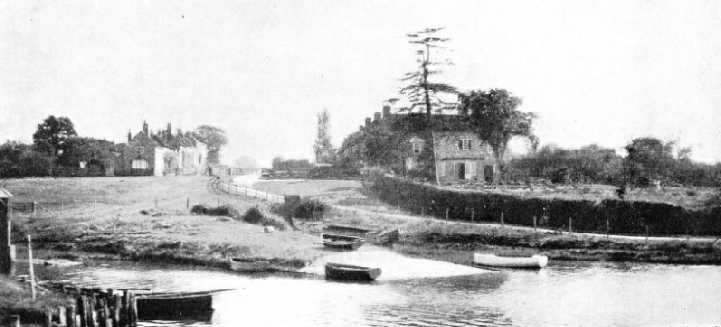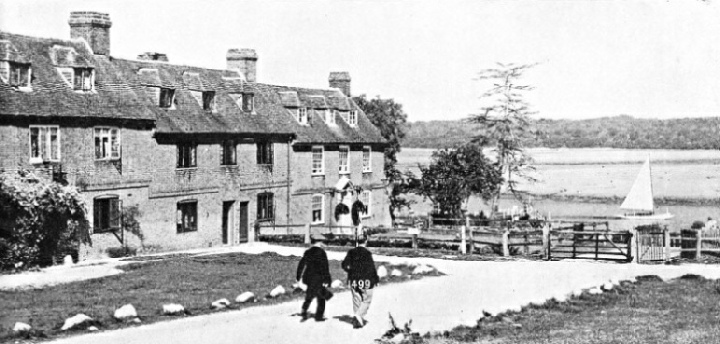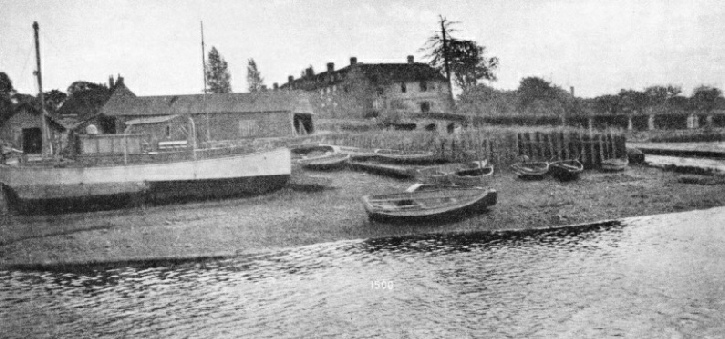

© Shipping Wonders of the World 2012-

“Wooden Walls” of Buckler’s Hard
Many famous warships of the eighteenth and early nineteenth centuries were built at Buckler’s Hard, on the Beaulieu River, Hampshire, a place conveniently situated near the stout oaks of the New Forest

ONCE A SCENE OF IMPORTANT SHIPBUILDING, Buckler’s Hard, on the peaceful Beaulieu River in Hampshire, is now a secluded hamlet. The river enters the Solent after a course of about 10 miles between rich meadows and forests of oak. Occasional patches of sand and gravel, known as “hards”, were convenient for shipbuilding purposes and in 1743 the first shipbuilding yard was established at Buckler’s Hard.
A VISITOR to the sylvan waters of the Beaulieu River, Hampshire, would find it difficult to associate the peaceful atmosphere which reigns there to-
Buckler’s Hard came into prominence during the first half of the eighteenth century. Many famous ships of the “wooden walls” era slid down its ways to do battle in defence of England and her Empire, including three vessels which were in Lord Nelson’s fleet at Trafalgar. The Beaulieu River has its source in the eastern edge of the New Forest and winds its way a short ten miles or so to the Solent, which it enters just opposite Gurnard Head in the Isle of Wight.
Half-
The largest and best of these is three miles below Beaulieu on the right bank and is close to a spring of fresh water. Used for centuries by fishermen, it became known as Buckle’s Hard, probably a contraction of Buccleuch, and now known as Buckler’s Hard. It was here that John, second Duke of Montagu and grandson of the fifth Duke of Buccleuch, established Montagu Town. Owning extensive sugar plantations in the West Indies, he prepared plans for building a great port to handle his imports and to build his own ships.
The Beaulieu River having at its source a plentiful supply of good timber, the Duke soon realized the prosperity which would accompany shipbuilding, particularly as only four miles away were the Sowley Pond ironworks, where the great forge hammer was worked by a water wheel.
In the days of wooden shipbuilding oak was the principal wood used, on account of its toughness and durability. Its timbers, however, were short and great quantities were required, as many as 4,000 trees being felled for building a first-
The keel was laid first, followed by the stem and stern posts, ribs and beams. When these were all in their correct positions, work would cease for sometimes as long as twelve months to allow the timber to season in its shape, the whole being covered with a rough roofing to protect it from the weather. When work began again the seasoned planks for the sides were built on to the ribs, the deck planking was fitted to the beams, and then all was ready for “caulking and paying”, filling the seams between the planking with oakum and paying with hot pitch.
Great quantities of timber were being-
The Beaulieu River also had other advantages for shipping, among the most important of which were the privileges of a Cinque Port, exemption from taxes and the right to make local by-
By way of further inducements to attract an enterprising shipbuilder, a piece of land was offered, 170 feet deep by 40 feet frontage, at a yearly ground rent of only 6s. 8d., to include three loads of oak timber free for every house he should build.
These allurements appealed to the firm of Wyatt and Company, who had been shipbuilders at Bursledon, on the Hamble River, for some years. In 1743 they established a shipbuilding yard at Buckler’s (or Buckle’s) Hard. Although the Duke desired to perpetuate his name in this new industrial centre by calling it Montagu Town, the local inhabitants would have none of it. It was Buckle’s Hard to them and Buckle’s Hard it must remain. So it continued and prospered. Although in 1748 the Treaty of Aix-
The most prominent person associated with Buckler’s Hard shipbuilding was Henry Adams, who appears to have been overseer for Wyatt and Company when they built their first ship there, the Surprise, a 24-
Three Years on the Stocks
Henry Adams soon became Master Shipwright, and for the next half-
The frigate Surprise was already in commission with the Scorpion, an 18-
In 1764 the 64-
The Pandora, also launched in 1779, was sent out in search of the Bounty and those of her mutinous crew who cast Captain Bligh adrift in the ship’s launch with eighteen loyal men. Captain Valentine Edwards was in command of the Pandora and at Tahiti fourteen of the mutineers were discovered and summarily arrested. They were placed in a round house which had been built on the quarter deck and was called “Pandora’s Box”. On the homeward voyage the Pandora was wrecked in the Torres Strait, between Australia and New Guinea, in 1791, and but for the prompt action of a seaman in assisting the prisoners to get free of their irons they would all have been drowned. As it was four succumbed, together with thirty of the ship’s company.

THE MASTER BUILDER’S HOUSE is a fine Georgian building situated at the end of the wide village street nearer the river at Buckler’s Hard. The house belonged to Henry Adams, who was overseer for Wyatt and Company In 1745 when the 24-
The next ship of particular interest to be launched at Buckler’s Hard was the Agamemnon, in 1781. Nelson was appointed to her as captain in 1793, and in his opinion she was “without exception the finest ‘64’ in the Service”. She had many honours to her credit, including her great fight with the French 100-
The Agamemnon played a leading part at the siege of Bastia and Calvi, Corsica, where Nelson lost the sight of his right eye, and was at all the principal Napoleonic engagements. At Trafalgar she was commanded by Captain, later Rear-
Sir Edward Berry was First Lieutenant of the Agamemnon under Lord Nelson, and went with him when appointed to the Captain in 1796, being present at the attack on Santa Cruz at which Nelson lost his right arm. Some time afterwards, when King George III condoled with him on his misfortune, Nelson introduced Captain Berry and remarked that “I had not experienced great loss, as this officer was my right hand.” The Agamemnon ended her career by grounding in June 1809.
At Trafalgar there were two other ships built at Buckler’s Hard -
Last Ship Launched in 1818
The largest vessel to be built at Buckler’s Hard was HMS Illustrious, a 74-
And so the list of ships built at Buckler’s Hard goes on until 1818, when the last ship was launched from its slips. She was the Repulse, a small Revenue cutter. In just over seventy years some fifty-
Buckler’s Hard, however, had another reason for its loss of industry. When old Henry Adams retired from his labours, he was succeeded by his sons, Robert, Edward and Balthazar. Robert, after some years at shipwrightry, had entered the Navy as a purser and left his brothers to carry on the business. It appears that, left to their own devices, they became over-
Now all is quiet again at Buckler’s Hard. It is a “yachtsman’s paradise”, and a retreat for those who seek peacefulness. The few holiday-

THE OLD SLIPWAYS AT BUCKLER’S HARD were situated where the village street runs down to the Beaulieu River, near the Master Builder’s House. Three of the ships that took part in the battle of Trafalgar, the Agamemnon, 64 guns, the Euryalus, 36 guns, and the Swiftsure, 74 guns, were built at Buckler’s Hard. Nowadays the only vessels to be seen on the Beaulieu River are yachts and other small craft.
You can read more on “Battle of the Nile”, “Battle of Trafalgar” and “Smugglers and Revenue Cutters” on this website.